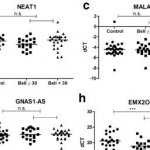boolybooly
Senior Member
- Messages
- 161
- Location
- Northants UK
Dr Fluks kindly posted this to an email group, I thought I better pass it on. Shows a signature in long non coding / functional RNA expression of sequences previously associated with immune processes.
https://translational-medicine.biomedcentral.com/articles/10.1186/s12967-018-1600-x
https://translational-medicine.biomedcentral.com/articles/10.1186/s12967-018-1600-x
The expression signature of very long non-coding RNA in myalgic encephalomyelitis/chronic fatigue syndrome.
Background
Myalgic encephalomyelitis/chronic fatigue syndrome (ME/CFS) is a chronic debilitating disease with huge social-economic impact. It has been suggested that immune dysregulation, nitrooxidative stress, and metabolic impairment might contribute to disease pathogenesis. However, the etiology of ME/CFS remains largely unclear, and diagnostic/prognostic disease markers are lacking. Several long noncoding RNAs (lncRNA, > 200 bp) have been reported to play roles in immunological diseases or in stress responses.
Methods
In our study, we examined the expression signature of 10 very long lncRNAs (> 5 kb, CR933609, His-RNA, AK124742, GNAS1-AS, EmX2OS, MIAT, TUG1, NEAT1, MALAT1, NTT) in the peripheral blood mononuclear cells of 44 ME/CFS patients.
Results
LncRNAs NTT, MIAT and EmX2OS levels were found to be significantly elevated in ME/CFS patients as compared with healthy controls. Furthermore, NTT and EmX2OS levels increased with disease severity. Stimulation of human monocytic cell line THP-1 and glioma cell line KALS1 with H2O2 (oxidative stress) and poly (I:C) (double strand RNA, representing viral activation) increased the expression levels of NTT and MIAT.
Conclusions
Our study revealed a ME/CFS-associated very long lncRNA expression signature, which might reflect the regulatory response in ME/CFS patients to oxidative stress, chronic viral infection and hypoxemia. Further investigations need to be done to uncover the functions and potential diagnostic value of these lncRNAs in ME/CFS.

